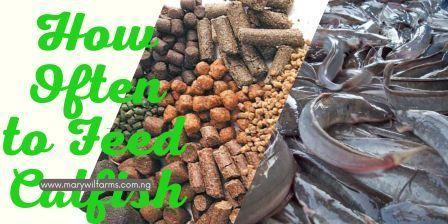Catfish Feeding & Nutrition
Hungry To Happy: How Often To Feed Catfish In A Pond

Catfish farming is an interesting business anyone can venture into. The business, however, requires some level of technicalities in the feeding, stocking, sorting, record keeping, and selling of the fish to the final consumer. To maximize catfish growth while in the pond, the question of how often to feed them has not received the right answer.
One of the most important things to figure out as a catfish farmer is how often you should feed and also figuring out the best time to feed them as well. Remember, quality feed is important not just to their growth but also to their survival.
Newly hatched fry should be fed several times daily, consuming 6–10 percent of their body weight, while fingerlings should be fed 2 to 5 percent of their body weight per day, ideally split into two feedings. For adult fish, feeding should consist of 1 to 2 percent of their body weight per day, with feeding frequency ranging from once to twice daily.
This means that catfish fries should be fed several times daily, fingerlings should be fed twice daily, and adult ones should be fed once or twice daily.
It can be pretty tricky especially for new farmers to determine the number of times they are supposed to feed their fish. In this post, we tend to provide answers to the right feeding frequency for catfish in a pond.
How Often to Feed Catfish in a Pond
When it comes to feeding catfish, it is important to strike a balance to ensure their health and growth. In general, catfish should be fed daily depending on the temperature and the age of the fish.
Catfish fries, fingerlings, and jumbo sizes have higher metabolic rates and require more frequent feeding, while bigger ones can be fed less often. Water temperature is higher, they tend to be more active and their appetite increases. In such cases, feeding more than twice may be necessary.
On the other hand, when the water temperature drops significantly, their metabolic rate slows down, and feeding frequency can be reduced to once or twice to avoid wastage.
It is important not to overfeed the catfish, as this can lead to water pollution or poor water quality that could result in disease outbreaks. Additionally, uneaten food can sink to the bottom and contribute to the accumulation of organic waste.
Observing the catfish's behavior and monitoring their body condition can help determine if adjustments need to be made to the feeding schedule.
My advice here is that
Newly hatched fry should be fed several times daily at 6–10 percent of body weight.
Fingerlings should be fed between 2 and 5 percent of their body weight per day. This could be twice daily.
Adult ones should be fed 1 to 2 percent of their weight per day. This could be once or twice daily depending on the farmer's choice.
The Importance of Feeding
Feeding catfish regularly with quality feed is essential for their growth and survival. These fish need a balanced diet to stay healthy.
Proper feeding also ensures the catfish reach table size at the appropriate time. Here are some of the key importance of feeding fish in a pond:
Growth and Weight Gain
Regular feeding helps to ensure that catfish receive adequate nutrition. Understand that good nutrition leads to healthy growth and weight gain. Proper feeding regimes allow catfish to reach marketable size faster, thereby maximizing their economic value
Nutritional Requirements
Catfish require a balanced diet to meet their nutritional needs. Commercial fish feeds are formulated to provide the necessary nutrients for the fish. Either you produce your feed by making use of our top catfish feed formulas to prevent nutrient deficiencies or you source them from the market.
Increased Survival Rates
Good feeding improves the survival rates of catfish. Quality feed builds stronger immune systems and helps prevent common catfish diseases. Providing sufficient nutrition also reduces cannibalism among catfish by satisfying their hunger and preventing aggressive behaviours.
Improved Fillet Quality
Feeding catfish with nutritionally balanced diets enhances the quality of their fillets. A well-fed catfish will have firmer flesh, a desirable taste, and a higher nutritional value. This aspect is particularly important for commercial catfish farming, as it directly affects marketability and consumer satisfaction.
Economic Benefits
Although there are fast-growing catfish species but quality feeding contributes also to how fast fish grow. Well-fed catfish grow faster, reach table size earlier, and produce higher yields. This leads to increased profitability for catfish farmers.
Factors to Consider When Determining Feeding Frequency
Now, let's take a look at two factors to consider when determining feeding frequency or rather how often one needs to feed his catfish especially when they are stocked in the pond:
- Water temperature
Water temperature plays a critical role in determining feeding frequency. The activity and metabolism of catfish decrease as water temperature drops. Therefore, catfish require less food during this time.
- Age and size of catfish
The age and size of your catfish will also determine how often you should feed them. Younger catfish need to be fed more frequently than mature ones. Smaller fish also require smaller servings of food.
Conclusion
Proper feeding is essential for the growth and survival of catfish. Understanding when and how often to feed catfish being raised in a pond is important for the overall growth and performance of the fish.
It is important not to overfeed your fish, as this can lead to water pollution or poor water quality that might result in disease outbreaks.



recent comments